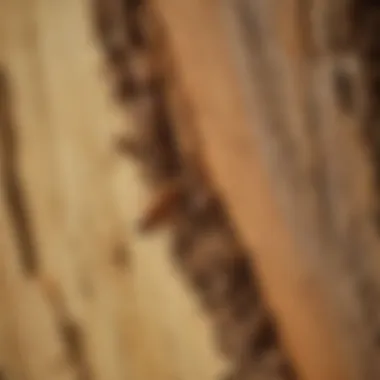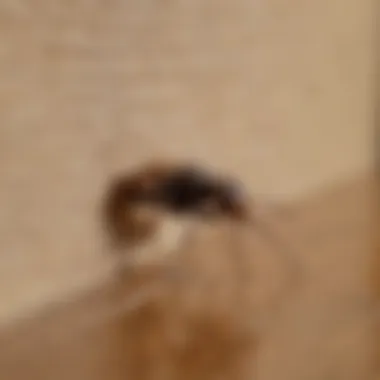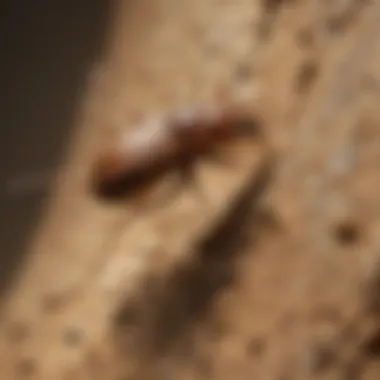Termite Inspection Guide for Fayetteville, NC


Intro
Termites pose a significant risk to homes in Fayetteville, North Carolina. Understanding their behavior and biology is essential for preventing infestations. Regular inspections play a crucial role in identifying these pests before they cause extensive damage. This guide delves into the various aspects of termite inspection, providing detailed insights useful for homeowners and pest control professionals alike.
Understanding the Pest
Identification
Identifying termites requires careful observation. The most common species in Fayetteville include the Eastern Subterranean Termite and the Formosan Termite. These termites are often confused with ants. However, termites have straight, beaded antennae and a broad waist. Their wings, when present, are equal in length and are longer than their bodies, while ants have a narrow waist and a noticeable bend in their antennae.
A close examination of wood can reveal signs of termite activity, such as tiny holes or the presence of sawdust-like frass. Recognizing these signs early can save homeowners significant costs in repairs.
Life Cycle
Understanding the life cycle of termites can enhance inspection strategies. Termites go through several stages: egg, nymph, and adult. The king and queen termites are responsible for reproduction, while workers and soldiers handle the colony's maintenance and defense. The average life span of a subterranean termite can reach upwards of two years. During the warm months, colonies can swarm, leading to new infestations if not detected in time.
Pest Prevention Strategies
Environment Modification
Altering the environment around your home can significantly reduce the risk of termite infestations. Keeping wood and debris away from the foundation is important. Additionally, all wood components, such as decks or fencing, should be properly treated with preservative chemicals.
Ensuring proper drainage around the house is also crucial. Termites thrive in moist conditions, so fixing leaky faucets or clogged gutters can make a big difference.
Physical Barriers
Physical barriers can deter termites from entering a structure. Installing metal mesh or sand barriers during construction helps to prevent infestations. Another effective option is to utilize concrete slabs during home building, as these are less vulnerable to termite activity.
Quote: A proactive approach in environment modification and physical barriers can prevent future infestations.
Control Methods
Chemical Control
Chemical treatments are common for managing termite populations. Liquid termiticides can be applied to the soil around a home’s perimeter. This creates a barrier that termites cannot cross. Additionally, bait systems might offer a targeted approach by attracting and eliminating a colony over time.
Biological Control
Biological control options are gaining traction as eco-friendly alternatives. Nematodes, microscopic worms, can be used to infect and kill termites in the soil. This method reduces reliance on harsh chemicals while still targeting the infestation effectively.
The integration of various control methods ensures a more comprehensive approach to termite management. Staying informed and vigilant is key in protecting homes in Fayetteville from these destructive pests.
Understanding Termites and Their Impact
Termites hold a significant position in the realm of pest management, owing to their unique biology and their potential to inflict immense damage on structures. Grasping the nuances of termite behavior and types is crucial for homeowners who wish to safeguard their investments and maintain the integrity of their living spaces. This section provides insights into the biology of termites, the various types present in Fayetteville, and the economic repercussions of infestations.
Biology of Termites
Termites emerge from a complex lineage, closely related to cockroaches. They live in colonies that can range from a few hundred to millions, depending on the species. A typical colony consists of a caste system, including workers, soldiers, and reproductive individuals. Workers are responsible for foraging for food, constructing tunnels, and maintaining the nest. Soldiers defend the colony against predators, while reproductive members focus on reproduction, ensuring colony longevity. Understanding this biology helps homeowners appreciate how quickly a termite issue can escalate, emphasizing the importance of regular inspections.
Types of Termites in Fayetteville
Understanding the types of termites prevalent in Fayetteville is essential for effective management strategies. Each species has distinct characteristics and behaviors, influencing the approach to inspections and treatments.
Subterranean Termites


Subterranean termites are perhaps the most common type found in Fayetteville. These termites burrow underground, creating extensive tunnel systems to seek out wood and cellulose materials for food. A key characteristic of subterranean termites is their colony size; they can consist of millions of individuals, enabling them to consume wood at a rapid pace. Their ability to remain hidden often leads to significant damage before they are detected. This feature makes them a critical focus in termite inspections, as they can compromise the structural integrity of homes before any signs become visible.
Drywood Termites
Drywood termites differ from their subterranean counterparts in that they do not require contact with soil. They infest dry wood areas, making them a concern for homeowners with wooden structures. A significant aspect of drywood termites is their ability to survive without moisture from the ground. This characteristic makes them particularly tough to combat once they infest a home. While they are less common than subterranean termites, the damage they cause can still be substantial. Inspections must specifically look for signs of drywood termite activity, such as small pellet droppings, which indicate their presence.
Formosan Termites
Formosan termites are considered one of the most aggressive termite species. Initially from Asia, they have made their way to the United States and are increasingly found in areas like Fayetteville. A notable aspect of Formosan termites is their ability to establish large colonies, often numbering in the millions. Their rapid reproduction and extensive foraging capabilities amplify their destructive potential. Due to their aggressive nature, inspections in regions where Formosan termites are known to exist must be particularly thorough. Effective treatment measures must be put in place rapidly to prevent extensive damage.
Economic and Structural Risks
The economic implications of termite damage are substantial. In Fayetteville, where the climate is conducive to termite activity, the risk of structural damage is a genuine concern for homeowners. Termites can silently consume wooden structures, leading to costly repairs that can add up to thousands of dollars if caught too late. Even minor infestations can escalate, complicating both repair and recovery efforts.
The structural integrity of a building is vital for safety and longevity. Understanding the risks associated with termite infestations highlights why proactive measures and inspections are essential. Ignoring the problem can lead to catastrophic results, not only on personal finances but also on the comfort of your home.
Importance of Termite Inspections
Termite inspections hold significant value for homeowners and property managers in Fayetteville, NC. Proper inspections can determine the presence of termites and prevent extensive damage. These pests can dismantle the structure of a home, leading to costly repairs and a decline in property value. Consequently, understanding the role of termite inspections becomes paramount.
Preventative Measures
Implementing preventative measures before an inspection can reduce infestation risks. Regular inspections serve as a cornerstone for maintaining the integrity of a property. Homeowners can incorporate several simple strategies:
- Regular Maintenance: Keep the property well-maintained to eliminate potential termite habitats. This includes fixing leaky pipes and removing wood debris from around the foundation.
- Moisture Control: Termites need moisture to thrive. Homeowners should ensure proper drainage around the foundation and examine areas prone to water accumulation.
- Barrier Methods: Installing physical barriers during construction, such as steel mesh, can serve as a deterrent against termite intrusion.
Establishing these measures not just protects against termites but also promotes an overall healthy living environment.
Identifying Early Signs of Infestation
Recognizing early signs of termite infestation is crucial. These insects can cause serious damage before they are discovered. Homeowners should actively look for:
- Mud Tubes: Subterranean termites build mud tubes to travel from their colony to food sources. These tubes are often found in moist areas around the foundation.
- Swarmers: During mating season, flying termites might appear inside homes, indicating a nearby colony.
- Damaged Wood: Wood that appears hollow or has small holes may signify termite activity. Tap areas of wood to check for a hollow sound.
Being vigilant about these signs allows for quicker responses, potentially saving homeowners from extensive damage.
Mitigating Costs Associated with Infestations
Costs associated with termite infestations can escalate rapidly. A structured, proactive approach to termite inspections can mitigate these costs. Here are some considerations:
- Early Detection: Regular inspections help identify infestations before they worsen. This early detection often results in less expensive treatments.
- Long-term Solutions: Investing in preventive treatments may reduce long-term maintenance costs. Chemical barriers or bait systems offer solutions that can prevent future infestations.
- Insurance Benefits: Some homeowners’ insurance policies cover pest control treatments. Checking with the insurance provider can provide additional financial support for inspection expenses.
Overall, the importance of termite inspections cannot be overstated. They are a pivotal element in securing homes against the damaging effects of termite infestations. Investing time and resources in regular inspections is a step toward maintaining property value and ensuring safety.
What to Expect During a Termite Inspection
Understanding the inspection process is critical for homeowners. Knowing what to expect can reduce anxiety and build confidence in managing potential infestations. A thorough inspection is not just about identifying existing problems. It also helps in assessing the overall health of your property. During an inspection, a trained professional will look for signs of termites, moisture issues, and potential entry points.
Visual Inspection Techniques
Visual inspection is fundamental in any termite evaluation. Inspectors often start by closely examining areas that are prone to infestation. These areas include basements, attics, and crawl spaces. Inspectors also check wooden structures, particularly those in contact with the ground.
The inspector looks for several signs:
- Mud tubes: These are often found along walls and foundations.
- Wood damage: Unexplained holes or crumbling wood can indicate termite presence.
- Frass: This is the excrement of termites. Finding frass is a strong sign of infestation.
Effective visual inspections require experience and a keen eye. An inspector who understands behaviors of local termite species, such as the Subterranean Termites and Drywood Termites in Fayetteville, can more efficiently identify risk areas.


Use of Technology in Inspections
Technology enhances inspection accuracy and efficiency. Professionals utilize various tools to find hidden infestations. These technologies not only allow for a deeper examination but also aid in quicker evaluations.
Moisture Meters
Moisture meters provide quick readings of moisture levels in wood and other materials. Termites thrive in moist environments, so identifying high moisture can indicate potential infestation sites. A crucial characteristic of moisture meters is their immediate feedback, which helps inspectors decide where to focus further investigation.
Moisture meters are quite popular in the industry due to their simplicity and effectiveness. Their unique feature is the ability to analyze moisture levels without causing damage to structures. However, while moisture meters can indicate potential risk areas, their readings must be interpreted within the context of mechanical damage or visual clues of infestation.
Termite Detection Equipment
Termite detection equipment includes devices like acoustic sensors and infrared cameras. These tools help identify areas where termites might be active but are hidden from view. A key characteristic of this equipment is its advanced nature. It can detect even small activities within structures.
Using these technologies significantly enhances the inspection process. However, the downsides include equipment costs and the need for trained personnel to interpret results effectively. This is crucial in ensuring you receive accurate evaluations during the inspection.
Evaluating Potential Damage
Evaluating potential damage is a critical component of any termite inspection. Inspectors assess not just current damage but also potential future risks. They look at structural integrity, especially in areas where wood is supportive. Identifying the extent of damage allows for proper planning of treatments.
After the evaluation, home owners receive detailed reports that include specific findings. This information helps in determining suitable treatment options. Effective evaluations also provide insights into preventative measures, ensuring long-term protection against termites.
In summary, understanding what to expect during a termite inspection can lead to more informed decisions about home maintenance, protection, and potential treatments.
Finding Qualified Professional Inspectors
Finding qualified professional inspectors is a pivotal aspect in the termite inspection process, especially for homeowners in Fayetteville, NC. The implications of hiring the right inspector extend beyond mere ant infestation detection; they encompass comprehensive pest management solutions that safeguard homes from potential structural damage. Individuals should approach this selection process with diligence, as it can significantly influence both the safety and value of their property.
Licensing and Qualifications
When seeking a professional inspector, it is crucial to ensure that they are properly licensed and qualified to conduct termite inspections. In North Carolina, pest control professionals must possess a license issued by the North Carolina Department of Agriculture & Consumer Services. This licensing signifies a level of expertise and adherence to industry standards. Additionally, many inspectors hold certifications from organizations such as the National Pest Management Association. These credentials reflect advanced training and understanding of termite behavior and treatment options. Engaging licensed inspectors means one can trust that they follow local regulations and understand specific challenges posed by local termite species.
Reputation and Reviews
Reputation plays a significant role in the selection of a termite inspector. Prospective clients should search for inspectors with a positive track record in Fayetteville. Online reviews on platforms like Yelp, Google, or even Reddit can provide insights into the experiences of previous clients. It is vital to look for inspectors known for their thoroughness, honesty, and ability to communicate findings clearly. A reputable inspector will take the time to explain their methods and findings, enabling homeowners to make informed decisions. Moreover, seeking personal recommendations from friends or local community groups can yield reliable options, as first-hand experiences are invaluable.
Cost Considerations
Cost is another important factor when selecting a termite inspector. Prices for inspections can vary based on several elements, including the size of the home, the extent of the inspection required, and the inspector’s experience. Homeowners should obtain multiple quotes to find competitive rates while ensuring quality of service is not compromised. Lower prices may sometimes raise concerns about thoroughness. Therefore, it’s essential to balance affordability with the inspector’s qualifications and reputation. Furthermore, some inspection companies may offer bundled services or maintenance plans which can provide long-term financial benefits and peace of mind.
Investing in a qualified professional for termite inspections can save homeowners substantial costs in the long run by preventing severe infestations.
Post-Inspection Actions
Post-inspection actions are critical for effective termite management in Fayetteville, NC. Once the inspection is complete, homeowners need to interpret the findings accurately and determine the best course of action. The inspection report serves as a key document, outlining any infestations or potential risks. Ignoring this document may lead to overlooked issues, which could escalate into more severe problems.
What follows is crucial for prevention and treatment, ensuring that structural integrity is maintained. Taking immediate action based on the report is essential to prevent further damage. Also, implementing a comprehensive plan post-inspection helps protect the home long-term against future infestations.
Understanding the Inspection Report
Understanding the inspection report is essential for homeowners. The report gives a detailed overview of the inspection findings, which includes areas of infestation and potential structural damages caused by termites.
Key elements of the report usually include:
- Location of Infestation: Clearly indicates where termites are active.
- Severity of Damage: Describes the extent of damage observed during the inspection.
- Recommendations: Suggestions for treatment and preventive measures.
By understanding these components, homeowners can prioritize actions based on the urgency and severity expressed in the report. Engaging with pest control professionals to clarify any confusing aspects enhances understanding and promotes informed decision-making.


Options for Treatment and Prevention
When dealing with termite infestations, various treatment options exist. Homeowners can choose between chemical treatments and non-chemical alternatives.
Chemical Treatments
Chemical treatments are popular in termite management. They function by applying pesticides specifically designed to eliminate termites effectively. One of the key characteristics of chemical treatments is their quick action in eradicating existing infestations. This method is often viewed as a beneficial choice due to its efficacy and speed.
A unique feature of chemical treatments is that they create a barrier around the home, which prevents future invasions. However, it is vital to note that some chemicals can be harmful to the environment and non-target species. This poses a disadvantage for eco-conscious homeowners. Considering these factors carefully helps in making suitable decisions.
Non-Chemical Alternatives
Non-chemical alternatives offer an eco-friendlier approach to pest management. These methods may include physical barriers, such as termite shields, or biological control methods like nematodes. A key characteristic of non-chemical alternatives is that they focus on prevention rather than extermination. This can be an appealing choice for those looking for sustainable solutions.
A special feature of non-chemical alternatives is their lower impact on the environment. They tend to be less harmful to surrounding ecosystems, which is an advantage for nature enthusiasts. However, these methods may require more time to show effective results, which can be a disadvantage for homeowners seeking immediate solutions.
Establishing a Maintenance Plan
Establishing a maintenance plan is an integral step after the inspection. Regular check-ups and preventive measures keep termite threats at bay. Maintenance plans typically include:
- Routine Inspections: Scheduling regular termite inspections can help catch any issues early on.
- Moisture Management: Maintaining dry conditions in and around the home is essential as termites thrive in moist environments.
- Landscaping Adjustments: Keeping wood and mulch away from the foundation can minimize risks.
Through a well-structured maintenance plan, homeowners can effectively manage termite issues and keep their properties secure against future invasions.
Local Regulations and Best Practices
Understanding the local regulations surrounding termite management and adopting best practices is essential for homeowners in Fayetteville, NC. Termite activity is not just a hassle; it can lead to severe structural damage if not managed properly. Being aware of state-specific laws can aid in compliance and enhance the effectiveness of prevention and mitigation strategies. Moreover, eco-friendly practices offer sustainable alternatives that benefit both homeowners and the environment. Community resources can serve as additional support channels, providing necessary guidance and assistance.
State Regulations in North Carolina
In North Carolina, regulations governing termite inspections and treatments are established to ensure safety and efficacy. The North Carolina Department of Agriculture & Consumer Services regulates pest control operators, requiring them to be licensed. This regulation ensures that only trained professionals conduct inspections and treatments.
Homeowners should always verify that their pest control company holds a valid license. Additionally, they must adhere to regulations regarding pesticide use. There are specific guidelines on approved chemicals and application methods that are designed to protect both health and the environment. By understanding these state regulations, homeowners can make informed choices about their termite management strategies, ensuring compliance and safety for their families.
Adopting Eco-Friendly Practices
Adopting eco-friendly practices in termite management is not just beneficial for the environment; it can also enhance the effectiveness of the control measures employed. For instance, using options like borate treatments or nematodes can reduce the reliance on hazardous chemicals. These alternatives are not only safer for families but also pose less risk to local wildlife.
In addition, proper landscaping techniques, such as maintaining healthy soil and vegetation, can deter termite activity. Homeowners can also consider using physical barriers like steel mesh or sand to protect their property from subterranean termites. By adopting these eco-friendly measures, homeowners can contribute to a more sustainable pest management approach while still protecting their investment.
Community Resources and Support
Fayetteville residents have access to various community resources that can assist in termite management. Local extension offices often provide information on pest management practices, including workshops and educational materials. These resources can help homeowners stay informed about the latest developments in termite control.
Additionally, community support groups or forums may exist where individuals can share experiences and advice. Websites like Reddit and Facebook can serve as platforms for discussion and group support, connecting homeowners who face similar challenges. By utilizing these resources, residents can enhance their understanding and implementation of effective termite inspection and management practices.
"Engaging with local resources can significantly improve your pest control outcomes and keep your home safe from termites."
Maximizing knowledge and staying compliant with local regulations are integral components of effective termite management.
Finale
In our exploration of termite inspection practices, we see that understanding the nuances of this topic is paramount. A well-structured inspection is not merely a precaution but a crucial first step in safeguarding homes from the devastating effects of termite infestations. This section synthesizes the essential elements discussed throughout the article.
Summary of Key Points
- Role of Inspections: Regular termite inspections serve as a line of defense against potential infestations. By identifying signs early, homeowners can prevent costly damages and maintain the structural integrity of their properties.
- Types of Termites: Familiarity with termite species, particularly those prevalent in Fayetteville, helps in recognizing specific threats. Subterranean, drywood, and Formosan termites each pose unique risks.
- Follow-Up Actions: Understanding the inspection report can guide homeowners in selecting effective treatment options, whether conventional chemical treatments or eco-friendly alternatives.
- Local Regulations: Compliance with North Carolina’s regulations ensures that inspections and treatments are effective and environmentally responsible.
- Community Resources: Utilizing local support systems can enhance pest management efforts. Homeowners can leverage community knowledge and expertise to tackle termite issues.
Final Thoughts on Termite Management
"Investing in termite inspections can be one of the most prudent decisions a homeowner makes, safeguarding their investment and providing peace of mind."
As we reflect on the insights shared, remember that knowledgeable decisions play a critical role in maintaining a pest-free living environment. By remaining vigilant, homeowners can not only protect their homes but also contribute to the overall health of the community.







